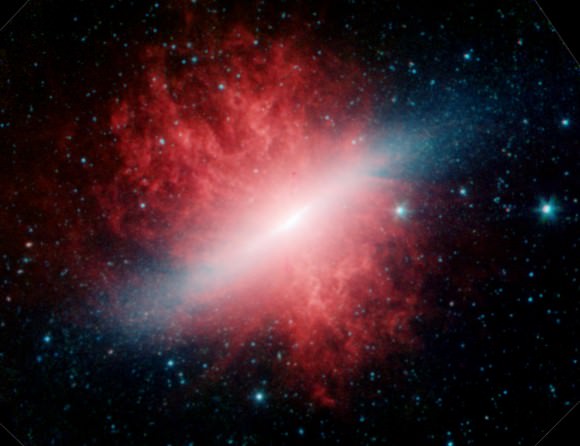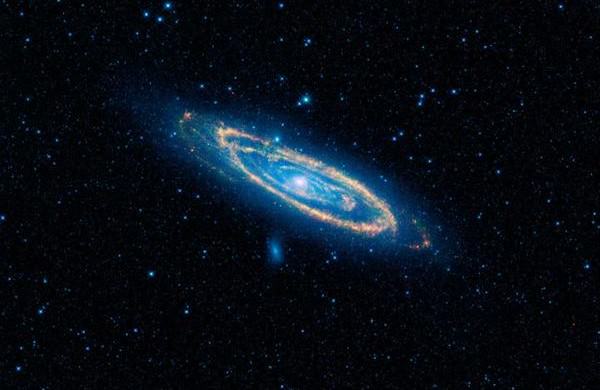Beam us up, Scotty. There’s no signs of intelligent life out there. At least, no obvious signs, according to a recent survey performed by researchers at Penn State University. After reviewing data taken by the NASA Wide-field Infrared Survey Explorer (WISE) space telescope of over 100,000 galaxies, there appears to be little evidence that advanced, spacefaring civilizations exist in any of them.
First deployed in 2009, the WISE mission has been able to identify thousands of asteroids in our solar system and previously undiscovered star clusters in our galaxy. However, Jason T. Wright, an assistant professor of astronomy and astrophysics at the Center for Exoplanets and Habitable Worlds at Penn State University, conceived of and initiated a new field of research – using the infrared data to assist in the search for signs of extra-terrestrial civilizations.
And while their first look did not yield much in the way of results, it is an exciting new area of research and provides some very useful information on one of the greatest questions ever asked: are we alone in the universe?
“The idea behind our research is that, if an entire galaxy had been colonized by an advanced spacefaring civilization, the energy produced by that civilization’s technologies would be detectable in mid-infrared wavelengths,” said Wright, “exactly the radiation that the WISE satellite was designed to detect for other astronomical purposes.”
This logic is in keeping with the theories of Russian astronomer Nikolai Kardashev and theoretical physicist Freeman Dyson. In 1964, Kardashev proposed that a civilization’s level of technological advancement could be measured based on the amount of energy that civilization is able to utilize.

To characterize the level of extra-terrestrial development, Kardashev developed a three category system – Type I, II, and III civilizations – known as the “Kardashev Scale”. A Type I civilization uses all available resources on its home planet, while a Type II is able to harness all the energy of its star. Type III civilizations are those that are advanced enough to harness the energy of their entire galaxy.
Similarly, Dyson proposed in 1960 that advanced alien civilizations beyond Earth could be detected by the telltale evidence of their mid-infrared emissions. Believing that a sufficiently advanced civilization would be able to enclose their parent star, he believed it would be possible to search for extraterrestrials by looking for large objects radiating in the infrared range of the electromagnetic spectrum.
These thoughts were expressed in a short paper submitted to the journal Science, entitled “Search for Artificial Stellar Sources of Infrared Radiation“. In it, Dyson proposed that an advanced species would use artificial structures – now referred to as “Dyson Spheres” (though he used the term “shell” in his paper) – to intercept electromagnetic radiation with wavelengths from visible light downwards and radiating waste heat outwards as infrared radiation.
“Whether an advanced spacefaring civilization uses the large amounts of energy from its galaxy’s stars to power computers, space flight, communication, or something we can’t yet imagine, fundamental thermodynamics tells us that this energy must be radiated away as heat in the mid-infrared wavelengths,” said Wright. “This same basic physics causes your computer to radiate heat while it is turned on.”

However, it was not until space-based telescopes like WISE were deployed that it became possible to make sensitive measurements of this radiation. WISE is one of three infrared missions currently in space, the other two being NASA’s Spitzer Space Telescope and the Herschel Space Observatory – a European Space Agency mission with important NASA participation.
WISE is different from these missions in that it surveys the entire sky and is designed to cast a net wide enough to catch all sorts of previously unseen cosmic interests. And there are few things more interesting than the prospect of advanced alien civilizations!
To search for them, Roger Griffith – a postbaccalaureate researcher at Penn State and the lead author of the paper – and colleagues scoured the entries in the WISE satellites database looking for evidence of a galaxy that was emitting too much mid-infrared radiation. He and his team then individually examined and categorized 100,000 of the most promising galaxy images.
And while they didn’t find any obvious signs of a Type II civilization or Dyson Spheres in any of them, they did find around 50 candidates that showed unusually high levels of mid-infrared radiation. The next step will be to confirm whether or not these signs are due to natural astronomical processes, or could be an indication of a highly advanced civilization tapping their parent star for energy.

In any case, the team’s findings were quite interesting and broke new ground in what is sure to be an ongoing area of research. The only previous study, according to the G-HAT team, surveyed only about 100 galaxies, and was unable to examine them in the infrared to see how much heat they emitted. What’s more, the research may help shed some light on the burning questions about the very existence of intelligent, extra-terrestrial life in our universe.
“Our results mean that, out of the 100,000 galaxies that WISE could see in sufficient detail, none of them is widely populated by an alien civilization using most of the starlight in its galaxy for its own purposes,” said Wright. “That’s interesting because these galaxies are billions of years old, which should have been plenty of time for them to have been filled with alien civilizations, if they exist. Either they don’t exist, or they don’t yet use enough energy for us to recognize them.”
Alas, it seems we are no closer to resolving the Fermi Paradox. But for the first time, it seems that investigations into the matter are moving beyond theoretical arguments. And given time, and further refinements in our detection methods, who knows what we might find lurking out there? The universe is very, very big place, after all.
The research team’s first research paper about their Glimpsing Heat from Alien Technologies Survey (G-HAT) survey appeared in the Astrophysical Journal Supplement Series on April 15, 2015.
Further Reading: Astrophysical Journal via EurekAlert, JPL-NASA

